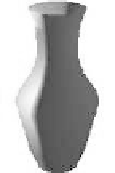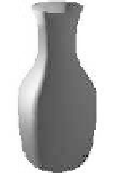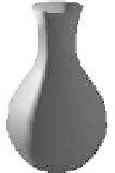Image Processing Reference
In-Depth Information
FIGURE 7.8: Simulating the local effect of a potter's hand by inserting
the control points (from left to right). Other operations (e.g., deletion and
repositioning of control points) are also incorporated in the algorithm. (See
color insert.)
Reprinted from
International Journal of Arts and Technology
,
4
: 196-215, G. Kumar et al., Copyright 2011, with
permission from Inderscience Publishers.
is that to achieve a good resolution for large objects, the number of cylinders
will be large, thereby requiring a large storage space.
Circular Sector Element Method: The pottery is composed from a num-
ber of circular sector elements with small internal angle and thickness. A
pottery can be deformed from outside to inside (contraction mode) or from
inside to outside (expansion mode) [132]. This is done by collision detection
between the individual sector elements and HIP. This method generates re-
alistic and e
cient models, but the simplicity of collisions limits the types of
decorations that can be made on the surface. Moreover, for rendering several
objects with high resolution, this method takes more time because of increase
in elements and subsequent collisions.
We discuss an e
cient technique here, in which the whole surface can be
represented by a finite number of control points and the axis of rotation.
7.2.2 Digital Curves and Surfaces
A 2-D digital curve segmentG := {p
i
: i = 1,2,...,n}is a finite sequence of
digital points in 2-D (i.e., 2-D points with integer coordinates) [115]. To ensure
that G is simple, irreducible, and open-ended, each point p
i
(i = 2,3,...,n−1)
should have exactly two neighbors, and p
1
and p
n
should each have one, from
G. Thus, the chain code of a point p
i
∈ G with respect to its previous point
p
i−1
∈ G is given by c
i
∈ {
0
,
1
,
2
,...,
7
} (proposed in [86], see also Section






















